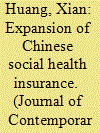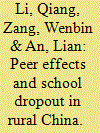| Srl | Item |
| 1 |
ID:
133816


|
|
|
|
|
| Publication |
2014.
|
| Summary/Abstract |
This article asks 'who gets what, when and how' from China's recent social welfare expansion. Little research to date examines the overall landscape of China's social health insurance, which has changed dramatically since 2003, and the distributive consequences and implications thereof. Drawing on public survey data and fieldwork for empirical support, this article finds that China's recent social health insurance expansion does significantly expand people's access to social health insurance. However, the expansion, which entails health insurance fragmentation and increasing benefit disparities, not only reinforces existing social cleavages such as the rural-urban divide, but it also generates new divisions within urbanites and workforce. Moreover, multiple social cleavages that cross-cut class differences have been institutionalized into China's social health insurance system. This reflects authoritarian regimes' 'divide and rule' tactic in social welfare provision.
|
|
|
|
|
|
|
|
|
|
|
|
|
|
|
|
| 2 |
ID:
124559


|
|
|
|
|
| Publication |
2013.
|
| Summary/Abstract |
This paper attempts to identify neighborhood peer effects on children's dropout decision in rural China using the China Health and Nutrition Survey data (CHNS). Identifying peer effect is complicated by several endogenity problems including "self-selection" problem, "reflective" problem and uncontrolled "correlated effect". By taking advantage of the special feature of "Hukou" system and "son preference" phenomenon in rural China, the endogenity issues are quite reasonably addressed. More specifically, we discover a new and valid instrumental variable for peer's dropout rate: peers' firstborn boy rate. Intuitively, the more the firstborn boy peers, the lower the peers' dropout rate because of son preference and the lower one's own dropout probability due to peer effect. It is found that as peers' dropout rates increase by one percentage point, the child dropout rate would increase by 0.393 to 0.504 percentage points, the corresponding social multiplier effects of peer dropout are from 1.647 to 2.016. It is also found that elder kids and females are more susceptible to peer pressure in dropout decisions. Many other interesting findings are documented.
|
|
|
|
|
|
|
|
|
|
|
|
|
|
|
|